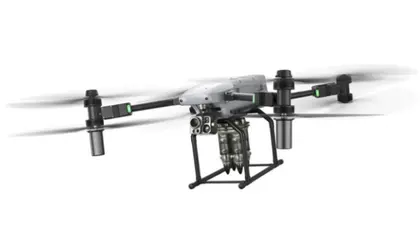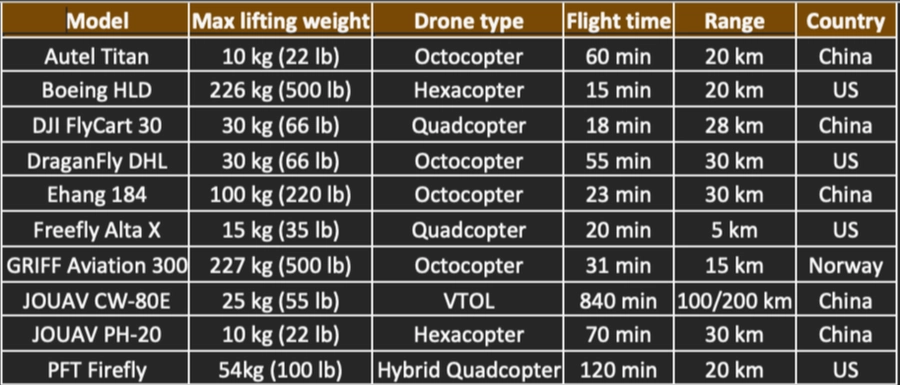The success of unmanned aerial vehicles (UAV), or drones as they are commonly known, on the battlefield in Ukraine’s war against Russia’s full-scale invasion have highlighted the ability of off-the-shelf, commercial drones to carry out a range of combat roles.
UAVs have proven to be ideal for surveillance, reconnaissance, intelligence gathering, accurately directing conventional artillery fire, dropping grenades with pin-point accuracy, and as FPV kamikaze drones.
JOIN US ON TELEGRAM
Follow our coverage of the war on the @Kyivpost_official.
The demand for larger drones to carry cargo was initially sparked by the interest of businesses, such as Amazon, to obtain a tool capable of delivering their goods directly into customers’ backyards.
With the exception of drones specifically designed for military use, drone manufacturers have tried to play down or even ignore the possibility of the use of their products in combat.
The use of drones on the battlefield is really only limited by the ingenuity of the user.
UAV manufacturers such as China’s Autel and DJI say they condemn the “misuse” of their drones for military purposes with some saying they have banned the sale of their products to both Ukraine and Russia, whereas everyone knows that they are easily obtained by both sides in the war through dealers.
As David Hambling pointed out in a recent article for Forbes, so ubiquitous is the presence of the DJI “Mavic” range of drones on the front lines in Ukraine, the term Mavic is now used by Kyiv’s troops when talking about any type of drone, just as “hoover” is used for any brand of vacuum cleaner.

Eurotopics: Ukraine War - What is Trump Up To?
He estimates that between them Ukraine and Russia have bought hundreds of thousands of the DJI drones.
Hambling also points out that Ukraine has already been deploying larger commercial drones, such as the DJI Matrice 300 and the locally manufactured Aerorozvidka and Kazhan UAVs, not only for long-range reconnaissance, but also as “bombers.”
Flown at night, to minimize the likelihood of being spotted, and fitted with night vision cameras, they are used to target Russian armored vehicles or defensive positions. They are able to accurately deliver payloads of between 5 and 10 kilograms which include modified anti-tank mines and anti-tank shaped-charge grenades.
In a number of cases the vehicles have been immobilized by an earlier FPV or artillery attack and the larger device is then used to finish the job. These nighttime attacks are much feared by Russian forces, who refer to them as “Baba Yaga” – the name of a witch from Slavic folklore.
The latest generation of cargo drones offers an even greater potential for adaptation as weapons delivery platforms through both a combination of a larger payload and/or extended range. A quick survey of what is available found ten commercial products that would fit the bill.
As shown in the picture above, the Spanish drone enthusiast Konrad Iturbe found marketing material on OBDPRICE.com, an authorized reseller of Autel products, which depicted its Titan cargo drone carrying four artillery-type munitions.
Patrick Senft, an analyst with the Netherlands-based Armament Research Services (ARES), dismissed the photos as an obvious mock-up as the payload “doesn’t resemble any munitions I’ve seen deployed by UAV,” the message that they could be used in this way is unambiguous.
The use of drones on the battlefield is really only limited by the ingenuity of the user. Up to now the majority of UAVs used during the war and the weapons they carry have been modified by “enthusiastic amateurs,” but now the professionals are getting in on the act.
Hambling mentions the test firing of an anti-tank guided weapon from a drone by the military drone maker AeroVironment, a stabilized weapon’s mount for a rifle or machine gun by the Spanish Baduga company, as well as the testing of a modified M72 anti-tank rocket form a drone by the Norwegian company Nammo-Buck.
Purpose-built military UAVs are also making an appearance, such as the BAE Systems Malloy Aeronautics heavy lift cargo drones, for which a wide range of capabilities are listed including: automated logistics and re-supply, casualty evacuation (CASEVAC), surveillance, mine countermeasures, close air support and anti-submarine warfare; the latter being demonstrated by a video of its T-650 drone launching a torpedo.
In July last year the UK Ministry of Defence posted a video of the Malloy T-400 in a CASEVC role and suggested that a number of the drones were being supplied to Ukraine as part of a UK aid package:
Sophisticated software keeps us at the cutting edge.
— Ministry of Defence 🇬🇧 (@DefenceHQ) July 21, 2023
Uncrewed aerial systems like Malloy drones, operated by the @BritishArmy can move equipment, weapons, and even casualties from the front line, and are part of our ongoing aid package to Ukraine. 👉 https://t.co/4lc6PtFw81 pic.twitter.com/kmdsKcpg6Y
Since equipment like Mallory will be built to exacting military standards and equipped with high tech EW countermeasures and so on, the price will reflect that. It is more likely that the attraction for Ukraine will be the cost of the commercial cargo drones.
The price for DJI FlyCart 30 was quoted as $17,000 when it was first unveiled in China in August and the Autel Titan price is likely to be around $52,000.
The latter boasts a number of safety features including intelligent all-round 720-degree obstacle avoidance, dual thermal imaging cameras, ADS-B signal receiver and A-Mesh networking technology.
The maker claims a deliver accuracy of +/- 15 centimeters – more than sufficient to drop something nasty through the turret of a T90.
So, while drone delivery services are currently limited by flight safety and other regulations there is a surefire customer base among the drone operators of the Armed Forces of Ukraine and the engineering teams behind them who have made “thinking outside the box” into an art form.
You can also highlight the text and press Ctrl + Enter







